| MSI 945GSE Board arrived | Created: 10.02.2009 23:23 Last modified: 18.02.2009 20:00 |
||||||||||||
I finally got my MSI 945GSE-A board today.
I have been looking for a proper Atom based mainboard for almost a year now.
"Proper" in this context means:
For starters, most boards used the 945 GC chipset. That chipset is just horrible for this application - the complete idiocy of taking a processor that uses only 2 - 4 watts and coupling that with a desktop chipset that uses 22 watts and usually requires active cooling should be pretty obvious. In contrast, the 945 GSE only uses 6 watts. And if you ever found a board that had two network interfaces, you could bet that it was either 100 mbit, or with a can't-handle-100-mbit-stable-leave-alone-gigabit chipset, or BOTH. The MSI now does fulfill all those: As the name suggests, it uses the 945 GSE chipset, and thus can be passively cooled without any problems. It also has two nice Gigabit intel NICs onboard. Plus DVI, VGA, the usual audio outputs, and even 2 serial ports on the back and 4 additional port headers on the board. The only downside I have found so far is that the 1.6 GHz hyperthreading Atom N270 used on the board is NOT a 64 bit processor, i.e. it cannot execute AMD64/Intel64 operating systems. Here are some pictures to make you jealous: 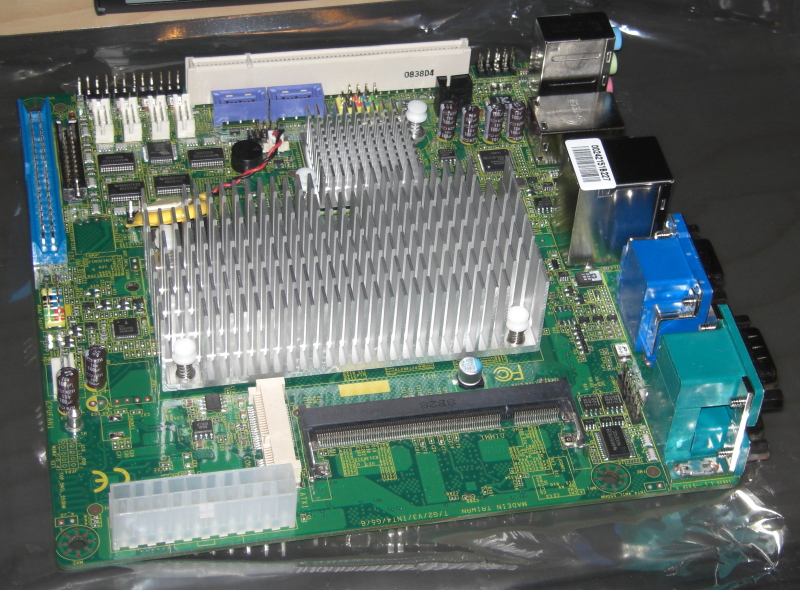 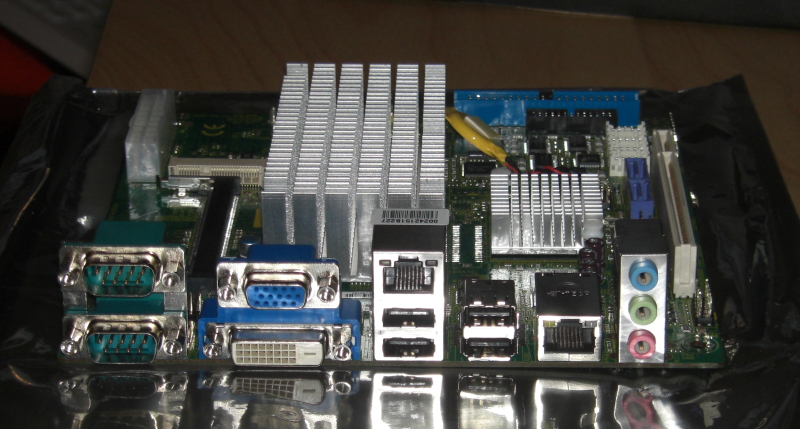 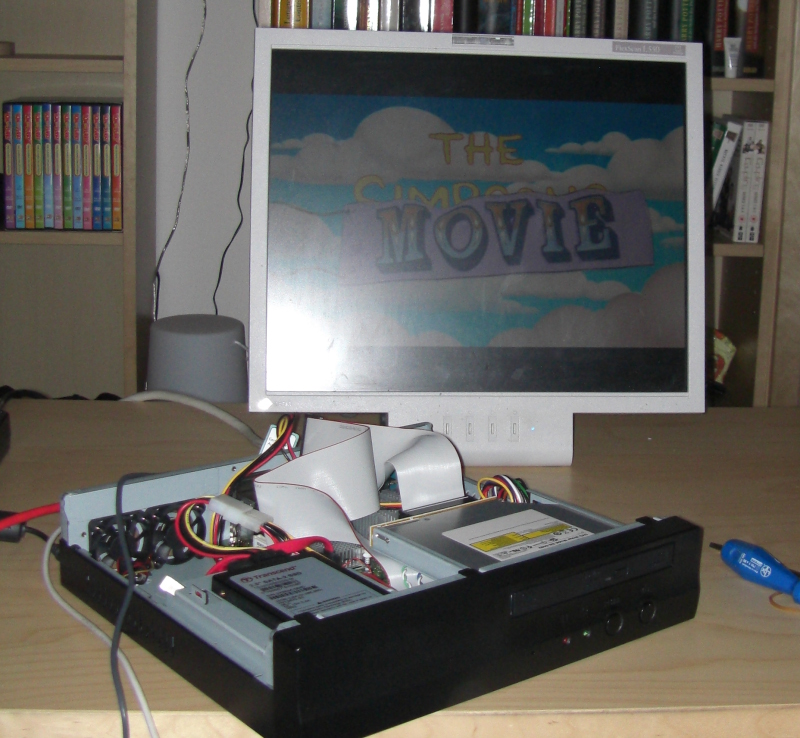 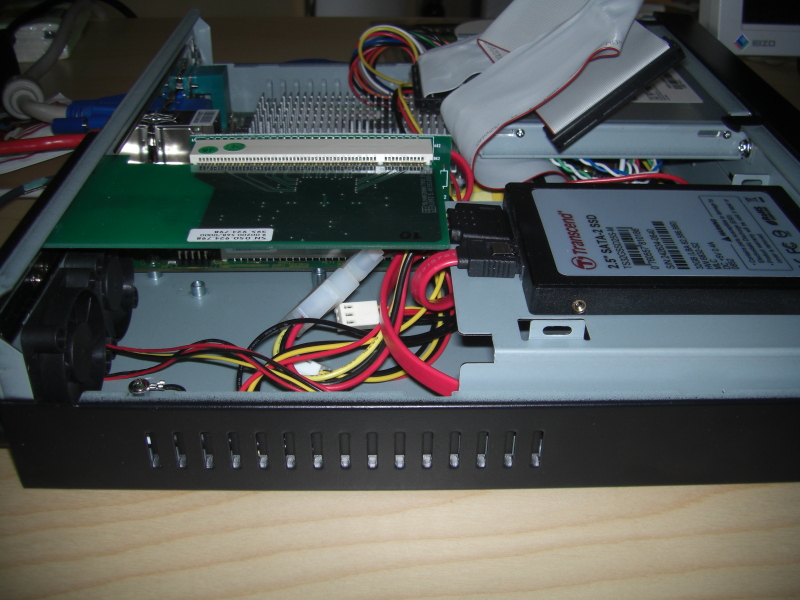 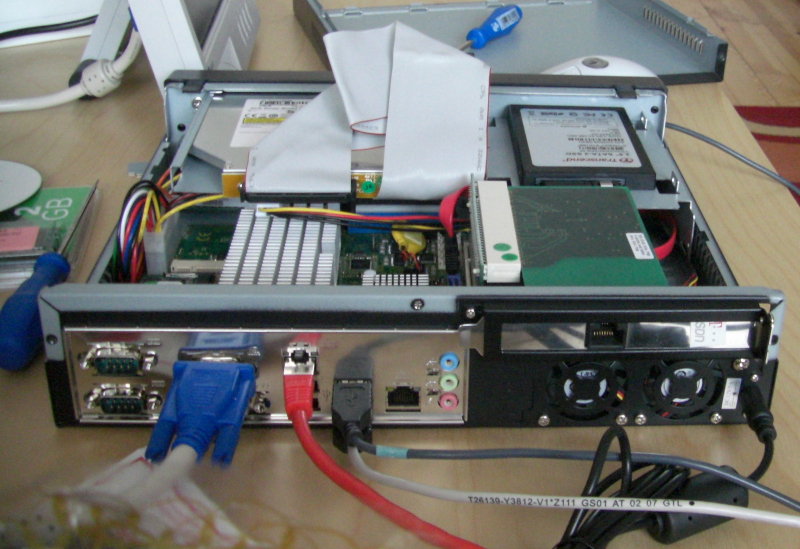 The case is a Morex Cubid 2677 V3.0. Note that the two case fans visible on the third picture are not connected. The case fits the board pretty well, there is only one slight problem: The power LED has a 3 pin connector, while the board has only a 2 pin header for connecting it. You will have to work around that if you want the LED to light - or you can chose to just not care and do without the green LED. The whole system has no moving parts except in the DVD ROM. Hard Disk is a 32 GB SSD. Power supply is in the front (below the DVD) and also fanless. It needs 12 volts / 5 amperes DC as input (supplied by an external fanless power supply) and generates the usual ATX voltages from that. With the case closed, lmsensors shows a CPU temperature of 84 degrees peak when compiling the linux kernel. As fas as I know, the allowed limit is 99 degrees on-die - note however that the 84 degrees mentioned are not measured oncore, but through a sensor on the board. I have no idea how good that sensor is, but it seems as if the CPU is close to its limits - why they did not put a larger heatsink onto it when clearly they had the space beats me. Edit: My trusted source for processor electrical specifications tells me that the official limit is 90 degrees cover temp. That means temperatures are probably OK, as the board sensor usually is below the processor, where the heat dams up. Installing Ubuntu Linux on the board proved a bit tricky. Although the hardware is all intel und thus very well supported by Linux, unfortunately the PCI IDs of the onboard NICs were not yet known by the e1000e driver in the installer of Ubuntu 8.04 (hardy, kernel 2.6.24) or 8.10 (intrepid, kernel 2.6.26). That makes a network install (as I usually do) a bit hard... I had to use the "jaunty" Beta for installation. It uses a 2.6.28 kernel and recognized the network interfaces without any problems. A collegue tried Opensolaris version 2008.11 on the board: The LiveCD saw the network just fine, but did not manage to bring up X - that however might be a result of the really old 14 inch monitor connected at that time. Here are some things I tried on the board, and whether it is fast enough or not. The CPU usage is taken from top and the sum of all relevant processes (e.g. mplayer and Xorg). Hyperthreading was enabled.
For measuring temperatures/voltages/fan speeds (should you really connect one), lm-sensors can be used: The board has sensors detected as Fintek F71882FG/F71883FG Super IO Sensors (linux kernel module f71882fg). In the same SuperIO chipset there also is a watchdog timer which can be enabled in the BIOS, but I have not found Linux-Support for it yet. Be careful when enabling it, it seems disabling it again is not that easy - only after setting timeout to 0, watchdog to disabled, saving, and then powercycling, it stopped resetting. I measured (or rather: estimated with the help of electrical equipment) the power consumption for the whole system (dvdrom, ssd, board, 2 gb memory in the case with the external and internal power supply) with my cheap ammeter: It shows 15.7 watts when idle, and a peak load of 20.5 watts (with 2 burnMMX and glxgears). For reference, here is the lspci -nn output from the machine: 00:00.0 Host bridge [0600]: Intel Corporation Mobile 945GME Express Memory Controller Hub [8086:27ac] (rev 03) 00:02.0 VGA compatible controller [0300]: Intel Corporation Mobile 945GME Express Integrated Graphics Controller [8086:27ae] (rev 03) 00:02.1 Display controller [0380]: Intel Corporation Mobile 945GM/GMS/GME, 943/940GML Express Integrated Graphics Controller [8086:27a6] (rev 03) 00:1b.0 Audio device [0403]: Intel Corporation 82801G (ICH7 Family) High Definition Audio Controller [8086:27d8] (rev 02) 00:1c.0 PCI bridge [0604]: Intel Corporation 82801G (ICH7 Family) PCI Express Port 1 [8086:27d0] (rev 02) 00:1c.1 PCI bridge [0604]: Intel Corporation 82801G (ICH7 Family) PCI Express Port 2 [8086:27d2] (rev 02) 00:1d.0 USB Controller [0c03]: Intel Corporation 82801G (ICH7 Family) USB UHCI Controller #1 [8086:27c8] (rev 02) 00:1d.1 USB Controller [0c03]: Intel Corporation 82801G (ICH7 Family) USB UHCI Controller #2 [8086:27c9] (rev 02) 00:1d.2 USB Controller [0c03]: Intel Corporation 82801G (ICH7 Family) USB UHCI Controller #3 [8086:27ca] (rev 02) 00:1d.3 USB Controller [0c03]: Intel Corporation 82801G (ICH7 Family) USB UHCI Controller #4 [8086:27cb] (rev 02) 00:1d.7 USB Controller [0c03]: Intel Corporation 82801G (ICH7 Family) USB2 EHCI Controller [8086:27cc] (rev 02) 00:1e.0 PCI bridge [0604]: Intel Corporation 82801 Mobile PCI Bridge [8086:2448] (rev e2) 00:1f.0 ISA bridge [0601]: Intel Corporation 82801GBM (ICH7-M) LPC Interface Bridge [8086:27b9] (rev 02) 00:1f.1 IDE interface [0101]: Intel Corporation 82801G (ICH7 Family) IDE Controller [8086:27df] (rev 02) 00:1f.2 IDE interface [0101]: Intel Corporation 82801GBM/GHM (ICH7 Family) SATA IDE Controller [8086:27c4] (rev 02) 00:1f.3 SMBus [0c05]: Intel Corporation 82801G (ICH7 Family) SMBus Controller [8086:27da] (rev 02) 01:00.0 Ethernet controller [0200]: Intel Corporation 82574L Gigabit Network Connection [8086:10d3] 02:00.0 Ethernet controller [0200]: Intel Corporation 82574L Gigabit Network Connection [8086:10d3] |
|||||||||||||
3 comments
write a new comment: |
|||||||||||||